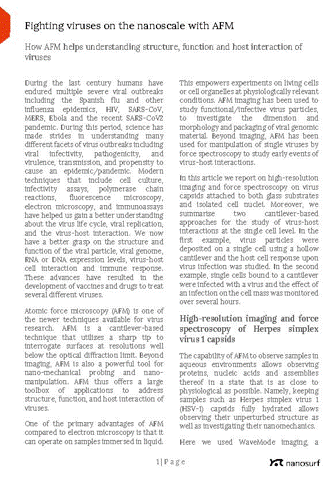Fighting viruses on the nanoscale with AFM
This application note focuses on the use of AFM in the study of viruses, particularly in understanding their structure, function, and interaction with hosts.
It highlights AFM's role in advancing our knowledge of viruses, complementing other techniques like cell culture, polymerase chain reactions, and electron microscopy. The note emphasizes AFM's ability to operate on samples in liquid, enabling experiments on living cells under physiological conditions. It reports on high-resolution imaging and force spectroscopy on virus capsids and summarizes cantilever-based approaches for studying virus-host interactions at the single-cell level.
Key learnings
-
Understanding AFM's Role in Virus Research: Learn how AFM contributes to the study of viruses, complementing traditional techniques in virology.
-
AFM Techniques for Studying Viruses: Gain insights into the use of AFM for high-resolution imaging and force spectroscopy of virus capsids.
-
Exploring Virus-Host Interactions with AFM: Understand how AFM is used to study virus-host interactions, including the manipulation of single viruses and the effects of infection on cell mass.
-
Advantages of AFM in Virology: Recognize the benefits of AFM in studying functional/infective virus particles and its capability to operate in liquid environments for physiological relevance.
-
Applications of AFM in Understanding Viral Mechanics: Discover how AFM contributes to our knowledge of the nanomechanical properties of viruses and their interactions with host cells.
